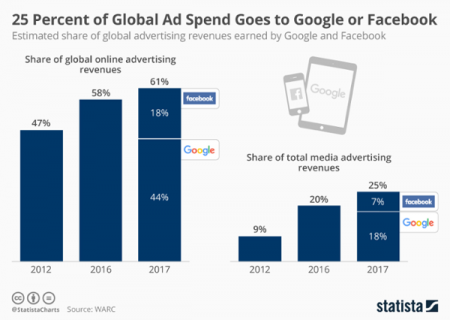July 9, 2018 – I don’t share every email blast that comes from Peter Diamandis’ incredibly interesting mind. Sometimes it is because the subject matter he describes has already been covered by this blog site. But I found this one today rather interesting because it points to how artificial intelligence (AI) will begin to dematerialize the advertising business. Without further ado, here are Peter’s thoughts.
In 2018 the global advertising industry is projected to surpass $550 billion with revenue from advertising driving Google’s valuation to in excess of $700 billion, and Facebook to over $500 billion. But all of that is about to change.
What if I were to tell you that the advertising business as we know it today is about to disappear… Collapse… Dematerialize?
Let’s dive in.
History & Perspective
The TV show Mad Men fictionalized the classic 1960’s Madison Avenue advertising agency, where print, TV, and radio ruled the roost and defined how companies pushed their products to the consuming public. There’s no question that when the dot-com revolution came along, few understood the disruptive impact of the technology. Now, less than two decades after the dot-com bust, Google, and Facebook combined, command more of the advertising market than all print media on the planet.
To provide perspective:
- Google’s ad campaign revenue totaled over $95 billion in 2017.
- Facebook’s ad revenue reached over $39 billion over the same period.
Both Google and Facebook, companies that are roughly a decade old, together make up roughly 25% of all global advertising expenditures. In these ten years, virtually the entire advertising industry has transformed itself into a digitized social media marketing business, fueled by open-source e-commerce platforms, mobile devices, and breakthroughs in digital payment infrastructure.

The Future Will Be Different When AI, Not You, Buy Stuff
The purpose of today’s advertising whether print or digital is to convince you to buy something. Advertisers extol the benefits. Buy this product because… it will make you more popular, more sexy, more successful, and so on. But what happens in the future when it’s not you making the purchasing decisions, but instead, your AI? Imagine a future when you simply say to JARVIS, your personal AI butler (named after the AI in Ironman) “Hey, I’m low on toothpaste, buy me some.” Does JARVIS watch the TV advertising campaign filled with bright-white smiles? No, of course not. In a nanosecond, the AI considers the molecular formulation of all the options, the pricing, the published client-satisfaction reports and finally, perhaps, evaluates your genome to understand exactly which flavour formulation is likely to excite your taste buds. And then it purchases.
Frankly, in the future, you’ll never have to actually ask your AI. JARVIS will be monitoring your supply of regularly consumed items, from toothpaste to butter, and will be able to order them “auto-magically” before you even know you need them.
How about the purchase of something new? Say, for example, a drone your son wants for his birthday. In this case, you’d likely just specify the functionality desired and ask “Hey JARVIS, could you buy me a drone for under $100 that is easy to fly, and that takes great photos?”
Even today, there are very few things that I want to go and buy myself, to look at advertising, do comparison shopping, and so forth. But what about fashion decisions? Are you going to trust your AI to choose your clothing? Probably not, but I do imagine an AI that listens to my daily conversations, tracking my eye movements as I window shop, and actively pattern matching me across my social circles. That AI will know what I like, which of my friends I tend to dress like, and it will do a pretty good job of selecting clothing choices for me.
We’re heading towards a future where, regardless of the product or service category, your AI will make the majority of your buying decisions. This is the paradigm shift that poses a tremendous threat to traditional advertisers and a revenue disrupter to the current online models subscribed to by Google and Facebook.
Conclusion
I often speak of the six D’s of exponentials: Digitized, Deceptive, Disruptive, Dematerialized, Demonetized and Democratized. Right now, we are experiencing the dematerialization and demonetization of advertising thanks to the power of artificial intelligence and the prominence of social networks. But perhaps there is a seventh D… Dismissed. Meaning that companies are going to be dismissed by the consumer, who will delegate their AI to make all purchase decisions. At the end of the day, my AI will make purchases for me based upon fundamental metrics: which product choice is the healthiest, the lowest cost, the safest, and best aligned with my social graph. I will not care about any advertisement, and when I have my AI make optimized decisions for me, I will no longer trust traditional advertising. For the consumer, and for those of you in the advertising business, the change is about to occur at an unprecedented rate.








